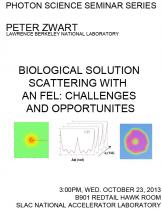Peter Zwart, LBL
X-ray solution scattering is a biophysical technique that has proven to provide essential insights in the structure and dynamics of macromolecules in solution. The advent of X-ray free-electron lasers (FEL), such as the LCLS open up new avenues in understanding the behavior of macromolecules in solution. Due to the very intense, ultra-short X-ray pulses from FELs, solution scattering data obtained at an FEL contains significantly more information as compared to data obtained at a more traditional X-ray source such as a synchrotron. The additional information in this data, manifested in scattered intensity fluctuations on the detector, arises from the absence of rotational averaging of the molecules in solution due to the ultra-short X-ray pulse lengths. Data obtained with this technique, which is known as fluctuation x-ray scattering (FXS), is in the form of the average, resolution dependent, angular autocorrelation function. This additional information can be used to remove ambiguities when deriving structural hypotheses and is thus a powerful tool to enhance standard solution scattering techniques. Recent theoretical and experimental work, performed at the AMO instrument, have indicated the feasibility of this technique on biological nano-particles with a dimension of 100nm. Further developments of hard- and software, such as increased FEL repetition rates and fully automated data reduction techniques, will ultimately allow this technique to be used to investigate complex biological systems in a high-throughput fashion, providing structural data that cannot be obtained at traditional light sources.





